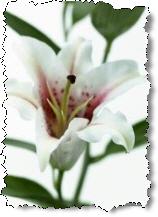

|
Keep the soil moist and well drained. Take care not to over-water. Our best advice for watering is to remove the flower from any decorative foil coverings, then water until the water begins to trickle out of the pot's drain holes. Remove the foil used in shipping Easter flowers to avoid waterlogged flowers and eventual root-rot.
As the mature flowers starts to droop and wane, remove them leaving only the fresher, newly-opened blooms.
Transplant Your Easter Flowers Outside
Easter flowers are a great addition to any garden plans. Ready to transplant your lilies? Here's how, in 3 easy steps:
-
Fix a well-drained garden bed in a sunny location with rich, organic matter. Use a planting mix, or a mix of one part soil, one part peat moss and one part perlite. Easter lilies must have good drainage.
-
Give the lilies a site with bright light but some shelter from extreme heat and wind. Easter lilies bloom naturally in the summer. If you plant your Easter flowers outdoors in the spring, they may bloom again in summer or fall. Otherwise, plant them any time in the fall before the soil freezes.
-
Plant Easter lily bulbs 3 inches below ground level, and mound up an additional 3 inches of topsoil over the bulb. Set your Easter lily bulbs at least 12 to 18 inches apart. Make the hole deep enough that the bulbs can be placed in it with the roots spread out and angled down. Work the soil in and around the bulbs and the roots. Water the flowers well, right after planting.
Easter lilies
take the spotlight as Easter flowers, yet there are many other wonderful choices
of spring flowers. Get more ideas for Easter flowers from our flower guide for
planting perennial
spring and Easter flowers.
Built by Champion Promotions Powered by SiteSell
www.lawn-and-gardening-tips.com
Copyright © by Robert Mosse, All rights reserved.
